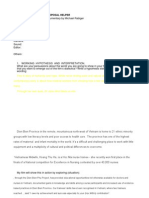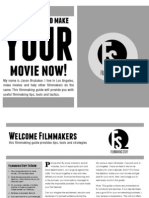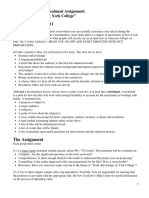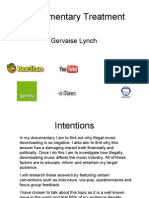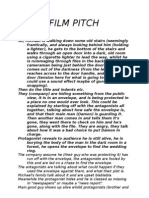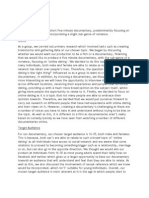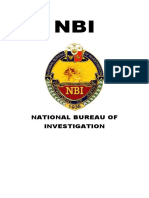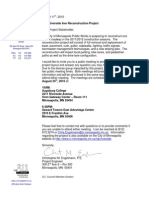Proposal Guide
Proposal Guide
Uploaded by
m0beenaCopyright:
Available Formats
Proposal Guide
Proposal Guide
Uploaded by
m0beenaOriginal Title
Copyright
Available Formats
Share this document
Did you find this document useful?
Is this content inappropriate?
Copyright:
Available Formats
Proposal Guide
Proposal Guide
Uploaded by
m0beenaCopyright:
Available Formats
DOCUMENTARY PROJECT PROPOSAL HELPER Adapted from Directing the Documentary by Michael Rabiger
Working title
Director: Camera: Sound: Editor: Others:
1. WORKING HYPOTHESIS AND INTERPRETATION. What are your persuasions about the world you are going to show in your film, the main statement that you want to emerge out of the films dialectics? Write a hypothesis statement incorporating this wording: In life I believe that:
My film will show this in action by exploring (situation):
The main conflict is between:
Ultimately, I want the audience to feel:
and to understand that:
2. TOPIC Write a concise paragraph about: a) Your films subject (person, group, environment, social issue etc.) b) The necessary background information the audience must have to understand and to be interested in the enclosed world you intend to present. Be sure to show how this information will emerge. 3. ACTION SEQUENCES Write a brief paragraph for each intended sequence that shows an activity. (A sequence is usually delineated by being in one location, one chunk of time, or an assembly of materials to show one topic). Incorporate the following: a) What the activity is and what conflict it evidences b) A metaphor to explain its subtextual meaning c) The expected structure of events d) What the sequence should contribute to the whole film and to the hypothesis e) What facts the audience must gather from watching it f) What key, emblematic imagery you hope to capture
4. MAIN CHARACTERS Write a brief paragraph about each of your main characters. For each include: a) Who (name, relationship to others in film and so on) b) Where (where does this person fit in the scheme of things?) c) What (what is this characters role, what makes the character(s) interesting, worthy of special attention and significant? What is this character trying to do or to get at?) 5. CONFLICT What is at issue in this film? Consider: a) Who wants what of whom? b) What conflicting principles do the characters stand for? c) Does your film put different principles in opposition (of opinion, of view, of vision and so forth)? d) How will we see one force finally meet with the other? (the confrontation--very important) e) What range of possible developments do you see emerging from this confrontation? 6. AUDIENCE BIASES To make a documentary means not only using conflicting evidence to put forward your subjects dialectics, it also means knowing what stereotypes or expectations carried by your audience your film must deliberately set out to alter. a) Biases ( may be positive or negative) b) What alternative views, facts or ideas does the audience need to understand c) What evidence will you show to get the audience to see those different truths 7. ON-CAMERA INTERVIEWS For each interview, list: a) Name, role in life, metaphoric role in films dramatic structure b) Main elements your interview will seek to establish 8. STRUCTURE Write a brief paragraph on how you hope to structure your film. When you are doing this, consider: a) How will you will handle the progression of time in the film b) How and at what point information important to story development will appear c) What you intend as the climactic sequence and where this should go
d) How this relates to other sequences in terms of the action rising toward the films projected crisis or emotional apex and the falling action after it e) Sequences or interviews you intend to use as parallel storytelling 9. FORM AND STYLE Any special considerations in shooting or editing style that might further your films content. Here you might comment on narrative lighting, camera handling, type and amount of intercutting, juxtaposition of scenes, parallel storytelling and the like. 10. RESOULUTION Write a brief paragraph about how you imagine your film will end and what you would like the ending to accomplish for the audience. Comparing any intended ending with the films beginning also exposes what must accompYish as a story to get there. The ending is your last word to the audience and has a disproportionate influence on what the film will mean. 11. BUDGET 12. LOGISTICS Briefly address any obvious problems of feasibility, practicality and so on.
You might also like
- Documentary Project Proposal HelperDocument5 pagesDocumentary Project Proposal HelperLeonie Jones67% (3)
- Film ResumeDocument1 pageFilm ResumeSam AthanasNo ratings yet
- Documentary ProposalDocument12 pagesDocumentary Proposalalejandra_sequeira_1No ratings yet
- Ganesha Pooja (Eng)Document23 pagesGanesha Pooja (Eng)satish kumarNo ratings yet
- Art of Editing Syllabus Spring 2021Document5 pagesArt of Editing Syllabus Spring 2021Zack RodgersNo ratings yet
- Take Action and Make: Movie Now!Document15 pagesTake Action and Make: Movie Now!Shajar RomeroNo ratings yet
- Documentary Film A PDFDocument3 pagesDocumentary Film A PDFaprakash babuNo ratings yet
- 001 Lighting For VideoDocument6 pages001 Lighting For VideoJesse JhangraNo ratings yet
- Video Production Proposal RbricDocument1 pageVideo Production Proposal RbricRichard MchikhoNo ratings yet
- Proposal of DocumentaryDocument1 pageProposal of DocumentaryKimberly BurkeNo ratings yet
- Masque of Red Death Question SheetDocument3 pagesMasque of Red Death Question SheetlauramariesandersNo ratings yet
- Pre-Production PROPOSAL ORGANIZER (Mid-Term 20%)Document5 pagesPre-Production PROPOSAL ORGANIZER (Mid-Term 20%)ccfno1No ratings yet
- DVB Proposal Template v1Document4 pagesDVB Proposal Template v1Juan Rodriguez-BrisoNo ratings yet
- Film Concept Development NotesDocument8 pagesFilm Concept Development NotesdphotoportsmouthNo ratings yet
- Tips For Writing A Proposal PDFDocument3 pagesTips For Writing A Proposal PDFNicolás SuárezNo ratings yet
- Screenplay Character Development: Step-by-Step | 2 Manuscripts in 1 Book | Essential Movie Character Creation, TV Script Character Building and ... Tricks Any Writer Can LearnFrom EverandScreenplay Character Development: Step-by-Step | 2 Manuscripts in 1 Book | Essential Movie Character Creation, TV Script Character Building and ... Tricks Any Writer Can LearnNo ratings yet
- The Role of Computer Graphic in Documentary Film Production PDFDocument35 pagesThe Role of Computer Graphic in Documentary Film Production PDFphilip davisNo ratings yet
- Question 1: in What Ways Does Your Media Product Use, Develop or Challenge Forms and Conventions of Real Life Media Products?Document4 pagesQuestion 1: in What Ways Does Your Media Product Use, Develop or Challenge Forms and Conventions of Real Life Media Products?SNM ProductionsNo ratings yet
- Writing A Script: A Two-Column Script Is An Easy Way To Structure and Plan For YourDocument2 pagesWriting A Script: A Two-Column Script Is An Easy Way To Structure and Plan For YourJillianne Jill100% (1)
- Documentary Proposal FormDocument1 pageDocumentary Proposal Formapi-394443105No ratings yet
- Defining Documentary FilmDocument13 pagesDefining Documentary FilmAshimaNo ratings yet
- To Understand How Genres Function To Identify Genre Codes and Conventions To Discuss Positives and Negative of Genre Branding-CompressedDocument22 pagesTo Understand How Genres Function To Identify Genre Codes and Conventions To Discuss Positives and Negative of Genre Branding-Compressedapi-394443105100% (1)
- Pre-Production Checklist: 1. Lock Shooting ScriptDocument2 pagesPre-Production Checklist: 1. Lock Shooting ScriptOtavio Villas BoasNo ratings yet
- Film Distribution: Definition of A DistributorDocument5 pagesFilm Distribution: Definition of A DistributorNinaNCNo ratings yet
- Documentary TreatmentDocument1 pageDocumentary TreatmentAnna DaviesNo ratings yet
- Video Project OutlineDocument2 pagesVideo Project OutlineAndyNo ratings yet
- 2 01 Documentary Proposal Form 2010 1Document5 pages2 01 Documentary Proposal Form 2010 1api-241144630No ratings yet
- Cinematic Documentary - HandoutDocument15 pagesCinematic Documentary - HandoutRingo DunnNo ratings yet
- 2 01 Documentary Proposal Form 2010Document7 pages2 01 Documentary Proposal Form 2010api-270166735No ratings yet
- CddssDocument5 pagesCddssVenkatesan AnbalaganNo ratings yet
- COMM 263 Radio/TV Production TV Studio Production Notes: Birth of TelevisionDocument16 pagesCOMM 263 Radio/TV Production TV Studio Production Notes: Birth of TelevisionhotalamNo ratings yet
- Guide To Japanese Film Industry & Co-ProductionDocument41 pagesGuide To Japanese Film Industry & Co-ProductioncandrijanaNo ratings yet
- Future of Story - Washington DCDocument1 pageFuture of Story - Washington DCMichael Wiese ProductionsNo ratings yet
- Project Proposal FormDocument1 pageProject Proposal FormmomomadNo ratings yet
- Film - Unit 26 Task 4Document23 pagesFilm - Unit 26 Task 4api-436900714No ratings yet
- Screenwriter: The Invisible WarDocument16 pagesScreenwriter: The Invisible WarLuvcite Digital Marketing AgencyNo ratings yet
- The Netflix Effect - Impacts of The Streaming Model On Television PDFDocument217 pagesThe Netflix Effect - Impacts of The Streaming Model On Television PDFAjay NigamNo ratings yet
- Film Finance 2Document31 pagesFilm Finance 2MARYKATE99No ratings yet
- Documentary WorkshopDocument27 pagesDocumentary WorkshopShwet KamalNo ratings yet
- Documentary TreatmentDocument11 pagesDocumentary TreatmentGervaise Lynch100% (1)
- Outline of FilmDocument10 pagesOutline of FilmozNo ratings yet
- Slow Documentaries The Long Take in Contemporary Nonfiction Films PDFDocument68 pagesSlow Documentaries The Long Take in Contemporary Nonfiction Films PDFseconbbNo ratings yet
- Terrific Ten Documentary ProposalDocument4 pagesTerrific Ten Documentary Proposalhramey92180% (1)
- Film PitchDocument5 pagesFilm PitchgwpahsmediaNo ratings yet
- An Introduction To GenreDocument16 pagesAn Introduction To GenrepancreatinfaceNo ratings yet
- Jessica's Production BriefDocument4 pagesJessica's Production Brieflil-miss-meghaniNo ratings yet
- DOCUMENTARYDocument22 pagesDOCUMENTARYNeftali Somintac100% (1)
- TreatmentDocument2 pagesTreatmentSerifeFilmNo ratings yet
- How They Cut Dialogue Scenes - Barry SaltDocument9 pagesHow They Cut Dialogue Scenes - Barry SaltMayara FiorNo ratings yet
- Documentary Treatment & Proposal TemplateDocument3 pagesDocumentary Treatment & Proposal TemplateCharlie HamptonNo ratings yet
- Examining The Foundations of Documentary Film The CoveDocument10 pagesExamining The Foundations of Documentary Film The CoveAL Babaran CanceranNo ratings yet
- The Pioneers of Film Editing and DevicesDocument4 pagesThe Pioneers of Film Editing and Devicesapi-328673354No ratings yet
- Birla College-SEM V-Documentary Filmmaking NotesDocument8 pagesBirla College-SEM V-Documentary Filmmaking NotesK P CreationNo ratings yet
- Shooting and Editing Underwater VideoDocument4 pagesShooting and Editing Underwater VideoHarsha VijaykumarNo ratings yet
- Cinematography Basics: I Year (Integrated)Document12 pagesCinematography Basics: I Year (Integrated)raviitherising0% (1)
- Film Editing Tutorial Film Editing Tutorial: Quick Start Guide! Terri Meyer BoakeDocument36 pagesFilm Editing Tutorial Film Editing Tutorial: Quick Start Guide! Terri Meyer BoakeYode akintundeNo ratings yet
- Movie TipsDocument5 pagesMovie TipsSurekha SettyNo ratings yet
- Defining Documentary FilmDocument8 pagesDefining Documentary FilmGAby YepesNo ratings yet
- The Film Industry: AS Media Studies Study Notes Unit G322 Section B Audiences and InstitutionsDocument14 pagesThe Film Industry: AS Media Studies Study Notes Unit G322 Section B Audiences and InstitutionsBen Wisdom-QuierosNo ratings yet
- The Practice, Etc.: TypesDocument3 pagesThe Practice, Etc.: TypesThe FandomNo ratings yet
- Documentary Sampl ScriptDocument10 pagesDocumentary Sampl ScriptRamona MerkanteraNo ratings yet
- COVID - MN Small Business Coalition Letter 3.16.20Document5 pagesCOVID - MN Small Business Coalition Letter 3.16.20FluenceMediaNo ratings yet
- W-P-221-Ar (1)Document29 pagesW-P-221-Ar (1)alashraam.2022mNo ratings yet
- Product CostingDocument12 pagesProduct CostinghanumaNo ratings yet
- Pengaruh Corporate Governance Terhadap Manajemen Laba Di Industri Perbankan IndonesiaDocument26 pagesPengaruh Corporate Governance Terhadap Manajemen Laba Di Industri Perbankan IndonesiaryaalwiNo ratings yet
- Vtiaco v. CADocument6 pagesVtiaco v. CAZader GazeNo ratings yet
- Associates Scott Mcbride and Michele Mcbride. Civil Racketeering Charges Remain - Witnesses SoughtDocument3 pagesAssociates Scott Mcbride and Michele Mcbride. Civil Racketeering Charges Remain - Witnesses SoughtPR.comNo ratings yet
- National Bureau of InvestigationDocument17 pagesNational Bureau of InvestigationKineNo ratings yet
- Breakfast: Classics SandwichesDocument6 pagesBreakfast: Classics SandwichesZain Bin AbdusSamadNo ratings yet
- AgronomyDocument8 pagesAgronomysmnationbadNo ratings yet
- RE: Riverside Ave Reconstruction Project: Department of Public WorksDocument2 pagesRE: Riverside Ave Reconstruction Project: Department of Public WorkssewardpNo ratings yet
- Map9 q4 Music AssessmentDocument4 pagesMap9 q4 Music AssessmentJovelyn A. MalizaNo ratings yet
- Adults Final TestDocument2 pagesAdults Final TesttutycandeNo ratings yet
- Provident Finance - Pemba G. SherpaDocument20 pagesProvident Finance - Pemba G. SherpaPemba Gyalbu Sherpa100% (1)
- Virgil - Aeneid (Trans. McCrorie) (Michigan, 1994)Document304 pagesVirgil - Aeneid (Trans. McCrorie) (Michigan, 1994)Leonardo Silva100% (1)
- What Can I Do With BBA LogisticsDocument2 pagesWhat Can I Do With BBA LogisticsswapanNo ratings yet
- Lon SOUTHERLAND, Doing Business As Southerland Tours, Appellant, v. ST. CROIX TAXICAB ASSOCIATION and The Government of The Virgin IslandsDocument8 pagesLon SOUTHERLAND, Doing Business As Southerland Tours, Appellant, v. ST. CROIX TAXICAB ASSOCIATION and The Government of The Virgin IslandsScribd Government DocsNo ratings yet
- Judicial PronouncementDocument69 pagesJudicial PronouncementmanasranNo ratings yet
- Urban Planning & Environmental ManagementDocument64 pagesUrban Planning & Environmental Managementsaren48No ratings yet
- Executive Summary Management AspectDocument8 pagesExecutive Summary Management AspectJheza Mae PitogoNo ratings yet
- City of Pasig Vs Republic - CDDocument2 pagesCity of Pasig Vs Republic - CDNolas JayNo ratings yet
- Profitability, Growth Opportunity, Capital Structure and The Firm ValueDocument22 pagesProfitability, Growth Opportunity, Capital Structure and The Firm ValueYohanes Danang PramonoNo ratings yet
- UntitledDocument1 pageUntitledDICU OLENKA-MARIANo ratings yet
- The Hull Floods of 2007Document4 pagesThe Hull Floods of 2007api-258813608100% (1)
- G20 Trade and Investment Ministers MeetingDocument18 pagesG20 Trade and Investment Ministers MeetingShreyNo ratings yet
- Department of Education: Weekly Home Learning Plan 2 Quarter Grade 7 - CharityDocument11 pagesDepartment of Education: Weekly Home Learning Plan 2 Quarter Grade 7 - CharityCharlene AtienzaNo ratings yet
- VBS Fearless Youth Teacher - S Manual - EnglishDocument50 pagesVBS Fearless Youth Teacher - S Manual - EnglishBless GelyNo ratings yet
- RWS ExamDocument3 pagesRWS ExamYAMILA NATASHA SURLANo ratings yet
- Times Leader 09-26-2013Document37 pagesTimes Leader 09-26-2013The Times LeaderNo ratings yet
